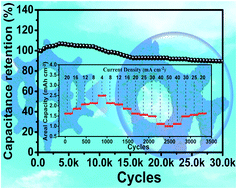The ultrasonic-assisted growth of porous cobalt/nickel composite hydroxides as a super high-energy and stable cathode for aqueous zinc batteries†
Abstract
To achieve aqueous zinc batteries with high capacity and superior durability, developing a scalable and efficient strategy for preparing an outstanding cathode is of pivotal importance. Herein, porous cobalt/nickel composite hydroxides supported on 3D Co–Ni foam (CNF) are used to construct a robust cathode (denoted as UTCNF) via a facile and cost-effective ultrasonic method that is suitable for scaling up to an industrial level. Attributed to the synergistic effects of the 3D foam architecture, the porous structure, and the in situ formation of electrochemically active cobalt/nickel composite hydroxides, the UTCNF//Zn battery exhibits excellent performance with a relatively high capacity (2.13 mA h cm−2 at 8 mA cm−2), excellent rate performance (47% capacity retention from 8 to 50 mA h cm−2), and superb stability (only ∼10% capacity loss after 30 000 cycles at a high current density of 40 mA cm−2). Furthermore, a maximum energy density of 3.99 mW h cm−2 and a peak density of 320 mW cm−2 are also attained. Notably, a soft-package battery that uses the UTCNF as a cathode demonstrates great potential as a power supply. This work may provide valuable ideas for the achievement of large-scale aqueous zinc batteries with high performance.



 Please wait while we load your content...
Please wait while we load your content...